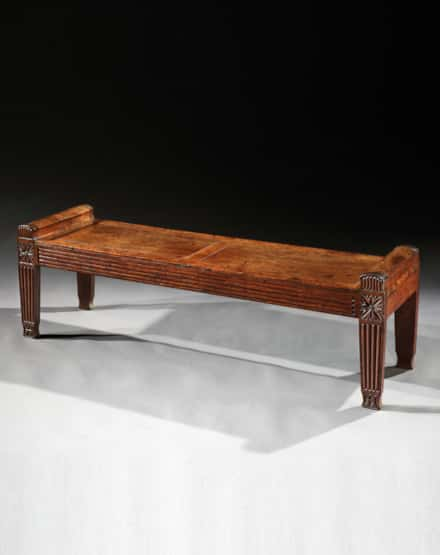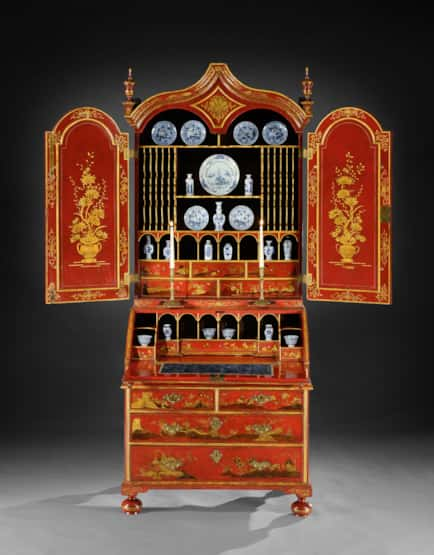AN IMPORTANT GEORGE II PERIOD CARVED SIDE TABLE
London, circa 1740
REF1114
An important George II Period Carved Side Table
London, circa 1740
The original rectangular marble top, veneered in quartered verde Antico, over a frieze of inverted breakfront form, finely carved with water leaves and flower and ribbon astragals with a sanded ground in between. The six legs formed of joined moulded pilasters carved with acanthus and water leaves, adorned with swags of fruit and flowers, with scrolled sides and imprecated reserves. The central frieze, joined by further swags of fruit and flowers and centred by a pierced cartouche.
Height: 2ft 8 in (82cm), Width: 5ft ¼ in (153 cm), Depth: 2ft 4 in (73cm)
PROVENANCE
H.R.H. Prince George, Duke of Kent.
H.R.H. Princess Marina, Duchess of Kent, until sold Christie's, London, Derby House, 13th March 1947, lot 234
DESCRIPTION
This exceptional table is inspired by the designs of William Kent (1685 - 1748) in particular, the bold architectural form and imprecated ‘fish scale’ reserves, adorned with festoons of flowers and fruit are classic elements found in his designs. While this table is ‘Kentian' in overall style, the distinctive clustered column legs with foliate volutes also link it to Matthias Lock, who drew a table of similar structure and design, now in the Victoria and Albert Museum.
In addition, numerous other tables either by Kent or in the Kentian style have similar form.
A similar example is a pair of tables in Woburn Abbey – not only do these tables include similar festoons connecting at a central cartouche, but these are also one of the few examples with the larger volute at the top of the leg, as on this table, and not the bottom. Though these were in the Canaletto Room when Woburn first reopened in 1955, the later 1987 guidebook shows them in the State Dining Room and states that they were “made in 1757 by John West at a cost of £53.10s.”
A pair of tables in Hampton Court Palace, illustrated in the Duke of Cumberland’s Presence Chamber in Weber’s monograph on Kent but now in the Public Dining Room, also feature triple-clustered legs with volutes.
John Soane’s Museum hold a similar pair of tables (H22 and H23) that were explored in depth in an article in Furniture History.
A somewhat comparable table in the Metropolitan Museum in New York is attributed to Matthias Lock due to its similarity with the Lock drawing in the V&A
This magnificent table was in the collection of the Duke of Kent, Prince George, who was the younger brother of the Kings Edward VIII and George VI. He and Princess Marina, Duchess of Kent had residences at 3 Belgrave Square where this table formed part of the furnishings. After Prince George tragically died as part of the crew on an RAF aeroplane in 1942, Princess Marina sold their collection of furniture in May 1947; this table was sold as lot 234.
YOU MAY ALSO LIKE
AN IMPORTANT GEORGE II PERIOD CARVED SIDE TABLE







 PRINT
PRINT SHARE
SHARE


